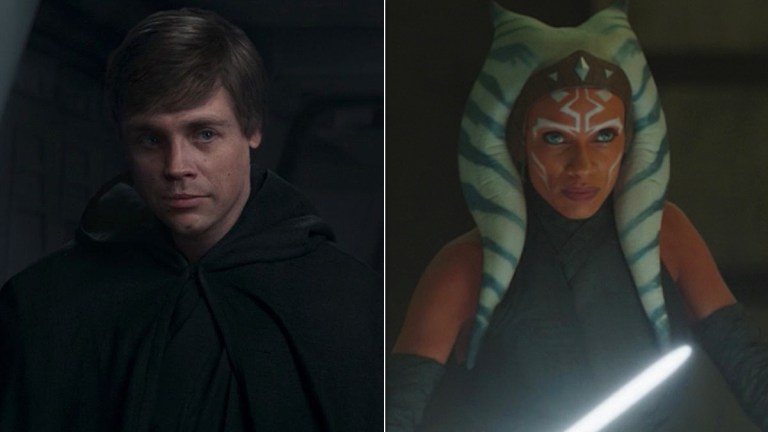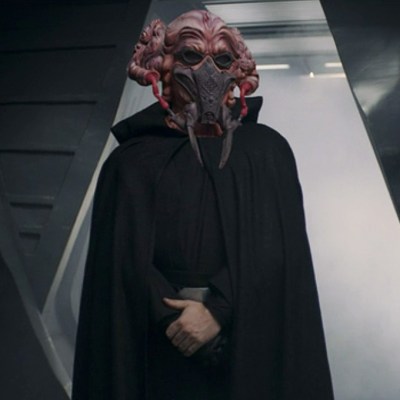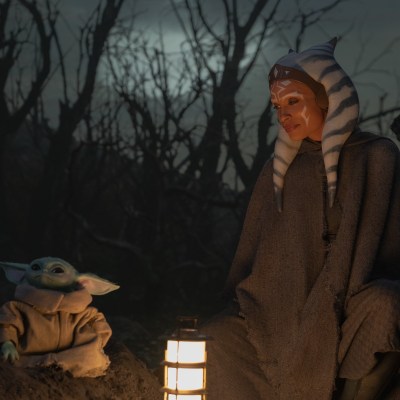The Mandalorian: How Luke’s Powers Compare to Ahsoka’s
Luke Skywalker may be Star Wars’ beloved original hero, but are his powers in the same league of Ahsoka Tano's?

Just last year, The Mandalorian’s unforgettable second season finale provided the post-Original Trilogy version of Luke Skywalker some Star Wars fans have long craved. As he sliced through his Imperial enemies on his way to rescue our heroes, it was apparent that the original Star Wars protagonist’s powers had increased exponentially in the five years since Return of the Jedi. It was a notion that reinforced the belief that Luke is the most powerful Jedi in the galaxy.
But is that really the case?
The impressive live-action debut of animated icon Ahsoka Tano earlier in the season invited a debate on Jedi powers. It’s a topic that was recently reignited, thanks to comments from executive producer Dave Filoni.
The recent premiere of Disney+ documentary series Disney Gallery: The Mandalorian Season 2, Episode 2 has proven profoundly revelatory about the technological magic that brought a Return of the Jedi-era Mark Hamill back onscreen in 2020 as Luke Skywalker for The Mandalorian “Chapter 16: The Rescue.” Interestingly, it also revealed the thought process that went behind the way that this rendition of Luke would be presented, powers-wise.
The scene in question, while poised to deliver the reddest of red meat moments to the fandom, still needed to be executed with the narrative discipline to present Luke as an awe-inspiring Force-powered figure while avoiding the pitfalls of making him an obscenely overpowered plot-lifting deus ex machina. However, in explaining his thought process on limiting Luke’s powers, Filoni unwittingly kicked an Ahsoka-shaped hornet’s nest.
“It would be very easy to just make [Luke] so over-the-top skilled,” says Filoni in the episode. “But I was like, ‘You know, what’s interesting is he’s had training, but I don’t know who’s been teaching him sword-fight training lately.’ So, he had to have a style that was better than what we saw in Jedi, but fundamentally still of the same tree of sword-fighting technique. And his technique and Ahsoka’s technique should be very different. And technically, she’s had vastly more training than he ever has. She’s actually his senior, which is, I think, difficult for people to remember ‘cause of when these characters were created.”
Filoni’s comment led to a debate of sorts on (where else?) Twitter, the welcoming social media hub for measured, mature, and always-respectful discourse over differing opinions around pop culture. Possibly attributed to perceived bias on the part of Filoni (as Ahsoka’s creator), the comment was taken as a claim that Ahsoka is more powerful than Luke. While that, of course, remains subjective, his comment about Ahsoka being Luke’s senior is factually accurate based on the canonical timeline of events in the Star Wars universe. Additionally, her training in the ways of the Force was substantially longer and more formal. While that doesn’t necessarily make her more powerful, it does likely mean that she’s more knowledgeable about the Force than Luke, not just from being older, but due to the pedigree of her Jedi training.
Ahsoka’s academic program started after being found by Jedi Master Plo Koon as a small child on her native planet of Togruta, after which she went through the regular academic wringer at the Jedi Temple under the direct tutelage of myriad Jedi Knights and Masters, patiently trained to harness her innate Force powers in what was to be a life-long learning endeavor. Indeed, the grandiose, elite life path of Jedi was first implied in The Phantom Menace when Yoda initially deemed an 8-year-old Anakin Skywalker “too old” to be trained in the ways of the Force. Clearly, Coruscant’s Jedi Temple is no one’s backup school.
Indisputable facts state that Ahsoka was wandering the galaxy toward the end of the Clone Wars as a formidable apostate Jedi well before Luke was even a forbidden gleam in the sand-hating Anakin Skywalker’s eye. We even witnessed a notable step in her extensive training process in Star Wars: The Clone Wars’ 2008 feature film, in which an adolescent Ahsoka—already a skilled fighter—was assigned as a Padawan learner to an initially-reluctant Anakin. Naturally, we saw Ahsoka’s skills evolve for years on the series, tested against the events of the titular war, and she would even rise to supreme splendor years later upon resurfacing on Star Wars Rebels to take on Darth Vader.
By the time we reach the post-Return of the Jedi era of Rosario Dawson’s live-action Ahsoka on The Mandalorian, she clearly achieved a sagely level—not just when it comes to her signature two-lightsaber combat style, but also deep wisdom regarding her spiritual connection with the Force, through which she was able to reveal Baby Yoda’s true name as Grogu. In the very least, most can agree Ahsoka would have a lot to teach Luke—that is, if they haven’t met already, which we don’t know for sure.
Nevertheless, in a stark contrast pertinent to our pandemic era, Luke Skywalker was the original distance learner, a product of institutional standards loosened out of necessity (in this case the extermination of the Jedi Order). His in-person training was—at least, as portrayed in the Original Trilogy—severely limited to a few fundamentals imparted ever-so-briefly by Obi-Wan Kenobi on the Millennium Falcon, and later from what amounted to a few days of Force training on Dagobah with Yoda.
In the arena of formally recognized Jedi credentials, Ahsoka is an Ivy League university graduate with workplace experience from years fighting the Clone Wars. Luke, on the other hand, came off a fast-tracked Jedi GED to earn a Jedi Skills Certificate from the proverbial online school of discovered Jedi texts and holocrons, making him a galactic Zoom class student, presumably deprived of opportunities to physically implement what he’d learned.
Of course, those ideas don’t necessarily seal the deal in the Luke/Ahsoka debate (if it even is a debate) since the true extent of Luke’s post-Jedi education is not really known. While “The Rescue” didn’t answer the question of who’s been teaching Luke advanced lightsaber techniques, the ease and stylistic panache with which he single-handedly dispatched a heavily-armed and armored platoon of Moff Gideon’s robotic Dark Troopers make it abundantly clear that his combat skills somehow evolved substantially from the rudimentary wide swipes and overhead caveman-swings showcased in Return of the Jedi. Thus, Luke’s upgraded skills seem attributed to something far more substantial than ancient books. But his life in the post-Original Trilogy, pre-Sequel Trilogy remains largely unexplored in the Disney era, so we don’t know the exact answers.
However, as we’ve seen with the Force, combat skills don’t necessarily make one more powerful, at least not in the manner through which the Jedi view the balance of the universe. For example, Qui-Gon Jinn was defeated in a duel with a mere Sith apprentice, Darth Maul, but his spiritual knowledge facilitated a subsequent trail-blazing ascension to the living Force, becoming the first fully-manifested Jedi Spirit, as vaguely teased in the Prequel Trilogy, and showcased on Star Wars: The Clone Wars.
Matthew Stover’s novelization of Sequel Trilogy closer Revenge of the Sith provides a key contextual moment omitted from the film, since Qui-Gon appears to Yoda fully-manifested as a Jedi spirit, offering to teach him the technique. At that point, the ancient and conventionally more-powerful Jedi master admits his hubris and exercises humility, stating to the spectral Qui-Gon, “A great Jedi Master you always were, but too blind I was to see it. Your apprentice, I gratefully become.”
Pertinent to this point, the version of Luke we saw over 30 years beyond the timeline of his monumental Mandalorian moment in sequel films The Force Awakens and The Last Jedi may have been—to much controversy—disheveled, disenchanted, and oddly-indifferent, but he was able to demonstrate some unprecedented Omega-level abilities (to borrow from the X-Men’s parlance). This idea proves that Luke’s Force education—such as it was—was nevertheless substantial enough for him to form a Jedi Academy to carry on the lost traditions—tragic ending of said academy notwithstanding. Consequently, any earnest debate about which Jedi is more powerful would likely require far more detail and nuance than the various agendas of the Twittersphere are able to conjure.
The Mandalorian season 3 will hit Disney+ sometime in 2022.

